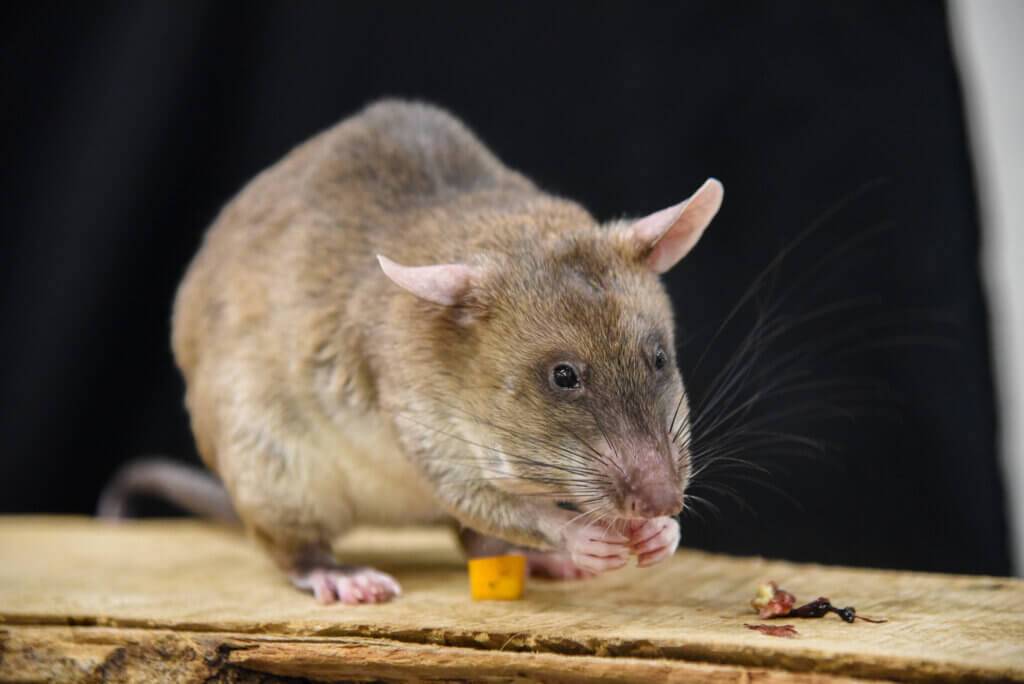Overview
“Where I live”
East African savannah pouched rats are native to tropical regions of southern Africa, including Zimbabwe, Kenya, Tanzania, Zambia, and Democratic Republic of Congo. This species is adapted to survive in relatively diverse habitats, including savanna, woodlands, and forests. They use their teeth to excavate burrows at the base of boulders or trees.
“How I live there”
The East African savannah pouched rat is typically solitary, and each individual occupies a burrow system. A pouched rat uses its burrow for shelter and as a place to cache (store) food. The task of stocking the pantry is made more efficient with the rat’s well-developed cheek pouches. Like built-in tote bags, the cheek pouches allow the rat to transport food from an abundant food source back to the burrow to keep for later.
For rodents in general, the sense of smell is critical for finding food, avoiding predators, recognizing both their mates and competitors, and moving through their environment. This sensory ability is even more highly developed in pouched rats. Compared to the brains of other rodent species that live in their range, the brain of a pouched rat has a much larger cortex and olfactory bulb–structures that are important for processing scent information.
“Making my mark”
Throughout the world, armed conflicts have left behind not only their painful legacies, but thousands of buried landmines. These unexploded weapons pose danger to people and wildlife in these areas. Because of the landmines, many people are unable to travel, carry out agricultural activities, or otherwise meet their basic needs due to the danger. And the lives of many have either been lost or dramatically changed due to the landmine explosions.
An organization called APOPO works in a number of countries to search for and remove landmines. The work of finding individual landmines falls largely to a group of trained pouched rats, known by many as HeroRATs. The extraordinary scent ability of this species and their intelligence make them highly effective. These super-sniffers are able to sense low concentrations of the explosive TNT coming from underground. When a trained HeroRAT smells TNT, it scratches the ground, and a handler will mark the location for removal. Harnessing their natural talents, the HeroRATs learn quickly, are diligent workers, and are easy to transport and care for in remote locations. And the rats are too lightweight to set off the explosives as they scurry over the fields. It takes a skilled person with a metal detector up to four days to clear landmines from an area the size of a tennis court. A HeroRAT can clear the same area in just 30 minutes. HeroRATs have helped APOPO find over 100,000 landmines, making the land safer for people and other animals that live there.
With their success in detecting landmines, pouched rats have been given a new assignment: detecting tuberculosis (TB) in humans. In Tanzania, a group of HeroRATs sniff samples coughed or spat out by patients. When sniffing a negative sample, the rat moves on, uninterested. When sniffing a likely positive sample, the rat scratches excitedly at the container. These HeroRATs generally act as the first-line screeners in these cases–the samples they identify as positive are sent for traditional screening.
“What eats me”
Large nocturnal birds of prey are primary predators of pouched rats. They are also hunted by mammals such as mongoose, civets, genets, and wildcats. In some regions, humans hunt pouched rats as bushmeat.
Raising Young
East African savannah pouched rats typically breed in the summer. In the range of this species, summer corresponds to the rainy season, which is generally September to May. After a pregnancy of around one month, the female gives birth in a nest to a litter of between 2 and 4 pups. The young remain in the nest until the age of about 6 weeks, when they leave to begin foraging. By the age of about 3 months, they leave the nest completely.
Taxonomy
- Kingdom: Animalia
- Phylum: Chordata
- Subphylum: Vertebrata
- Class: Mammalia
- Order: Rodentia
- Family: Nesomyidae
- Genera: Cricetomys
- Species: ansorgei
What is an Animal Ambassador?
The Maryland Zoo refers to its special collection of education program animals as “Animal Ambassadors.” The Zoo currently cares for more than 60 Animal Ambassadors, representing more than 40 species, both native and exotic. These animals are managed separately from the rest of the Zoo’s collection and cannot be seen on exhibit at the Zoo. However, many can be seen up close and personal on a rotating basis at Creature Encounters, the Zoo’s outdoor education center; at camp and school programs at the Zoo; as featured participants in community-based Outreach programs; and at special events on and off Zoo grounds.
Animal Ambassadors spend countless hours working with their human handlers, developing bonds of trust and communication that will allow them to appear in front of audiences large and small. They are not show animals. They behave naturally, focusing audiences’ attention on their natural behaviors and adaptations and giving living, breathing meaning to concepts and topics that students may be studying.
Animal Ambassadors travel all over the state of Maryland and beyond, and many also make local and national media appearances, educating about wildlife while representing the Zoo and its commitments to animal welfare and conservation.
What is The Animal Embassy?
The Animal Embassy at The Maryland Zoo is an off-exhibit area that is not open to the public. It is where the Zoo’s “Animal Ambassadors,” or education program animals, live. The Embassy is home to more than 60 individual animals representing more than 40 different species. It is staffed by its own dedicated group of keepers and volunteers and has both indoor and outdoor living space for the animals.

